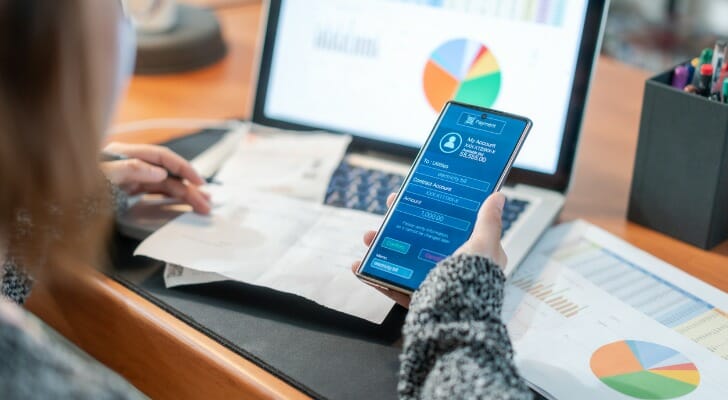Digital banking provides online banking services via the internet or an app. This type of banking access started back in the mid-1990s, with Stanford Federal Credit Union being the first institution to allow online banking activity. Digital banking occurs through either mobile or online bank access, allowing you to do activities like make a deposit or transfer money. This can make banking easier as it eliminates the need to physically visit a bank branch.
If you aren’t sure what type of financial institution to keep your money in, you could consider working with a financial advisor.
What Is Digital Banking
Digital banking generally refers to both mobile and online banking services through a website or a mobile app.
Mobile banking, in particular, uses a proprietary app created by a specific financial institution for banking transactions and is designed for people on the go. Online banking, on the other hand, means using a website to complete your banking transactions. The combination of mobile and online banking makes up all digital banking activities.
With digital banking, you can do many of the things that used to require a trip to a physical bank branch, such as:
- Make deposits and withdrawals
- Open a deposit account
- Apply for credit cards or a loan
- Transfer money
- View balances
- Pay bills
- Withdraw cash
Before the advent of the Internet, it was not possible to access banking services without visiting a bank branch. However, increasing connectivity and affordability of devices have allowed digital banking to go mainstream.
Today, it is possible to do most of your banking entirely with a mobile app. The result is not only traditional banks adding online banking services but also a slew of online banks with no physical branches.
How to Bank Digitally

With more and more transactions happening online, there are many ways to bank digitally. While most traditional banks support online banking, an increasing number of banks are entirely digital, meaning that there are no physical locations. This makes it easier to complete transactions and can often save you on bank fees, but it could be difficult for those needing to frequently deposit cash.
Traditional Banks
Most traditional banks now allow their customers to carry out many basic banking tasks online through a web browser or a mobile app. For example, online banking through traditional banks lets you view balances, transfer funds, pay bills or wire money. You still have the option to visit a local bank branch to apply for a loan or deposit cash, but you also have the option to never step foot in a branch again if you don’t need to.
Online Banks
The digital age has also enabled the founding of many online-only banks, where all banking is done digitally. Not all online-only banks are the same – some are licensed as banks, while some partner with banks to hold their customers’ deposits. In some cases, online-only banks are entirely mobile and may support banking via a web browser. These firms are sometimes referred to as neobanks or fintechs.
Some online banks have other perks, such as no overdraft fees and high-yield savings accounts. Their slimmed-down operations allow them to reduce overhead costs, and they often pass some of those savings to customers through increased rates on savings accounts or decreased fee structures.
If you don’t need to visit a local branch, this might be a great option to maximize your money.
Pros and Cons of Digital Banking
Digital banking undoubtedly represents one of the biggest transformations the banking industry has ever experienced. In fact, many traditional banks were very slow to adopt a full online banking product suite because it was so difficult and such a big change.
There are both pros and cons of digital banking to consider.
Pros of Digital Banking
- Lower fees: Online-only banks often have minimal fees because they eliminate the large overhead of maintaining physical branches.
- Convenience: Digital banking allows people to do most of their banking in the comfort of their homes without ever needing to visit a physical branch.
- Adaptability: Online-only banks are often more adaptable than traditional banks. Many online-only banks are startups, allowing them to be significantly more agile than big banks with thousands of employees. As a result, online-only banks can add features long before traditional banks roll them out.
Cons of Digital Banking
- Learning curve: Not everyone is used to digital banking. For those accustomed to visiting a branch in person, it will take time to adjust, especially when using a mobile banking app.
- Lack of physical branches: This can be a deal-breaker for people who need the option to talk to someone in person.
Is Digital Banking Safe?
Digital banking is generally considered safe due to the use of advanced security measures by financial institutions.
Most banks and credit unions use encryption protocols, secure login processes and automatic logouts to protect your data during online and mobile transactions. Features like two-factor authentication (2FA), fingerprint and facial recognition and transaction alerts all help prevent unauthorized access so you can avoid fraud.
While banks invest in cybersecurity to safeguard your information, user behavior also plays a key role in account security. Avoid accessing your bank account over unsecured public Wi-Fi and regularly update your device software to patch security vulnerabilities. Creating strong, unique passwords and monitoring account activity for unfamiliar charges can further reduce the risk of fraud.
If you suspect unauthorized access to your account, contact your bank immediately. Most institutions offer 24/7 customer support and fraud resolution services. Federal laws, such as the Electronic Fund Transfer Act can also limit your liability if you report unauthorized transactions quickly. Used responsibly, digital banking is a secure and efficient way to manage your finances.
Bottom Line

In today’s modern world, we are increasingly relying upon mobile solutions, but what is digital banking exactly? Digital banking generally refers to accessing banking services with a website or mobile app. With digital banking, customers can do most of their everyday banking tasks, such as viewing balances, making deposits and paying bills. An increasing number of banks are online-only, lacking physical branches but allowing customers to do all their banking online. These banks often have lower fees and better rates. However, their lack of bank branches could be a problem for some customers.
Tips for Opening a Bank Account
- When you’re looking to keep your money in any investment or financial institution, it is important to make sure it works with your financial plan. A financial advisor can help you work through your banking needs and put together a plan that works for your unique situation. SmartAsset’s free tool matches you with financial advisors who serve your area, and you can interview your advisor matches at no cost to decide which one is right for you. If you’re ready to find an advisor who can help you achieve your financial goals, get started now.
- If you plan to open a bank account, be sure to check SmartAsset’s checking & savings guide. Some checking accounts are better than others; for example, some have monthly fees and minimum account balances. Be sure to research the best options before opening a new checking account.
Photo credit: ©iStock.com/cofotoisme, ©iStock.com/AsiaVision, ©iStock.com/fizkes
